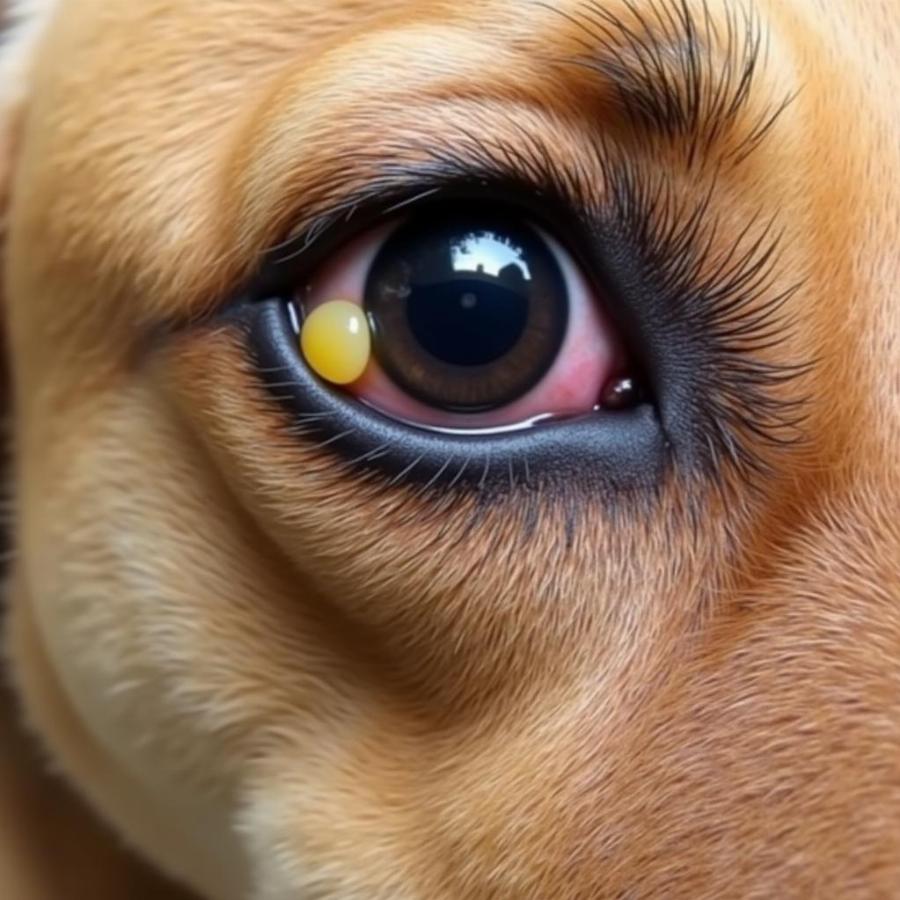Meibomian cysts in dogs, also known as chalazions, are small, typically benign bumps that develop on the eyelid. While usually not a cause for immediate alarm, they can sometimes cause discomfort or lead to more serious complications if left untreated. Understanding the causes, symptoms, and treatment options for meibomian cysts is essential for any responsible dog owner. This comprehensive guide will equip you with the knowledge to identify, manage, and prevent meibomian cysts in your furry friend.
Understanding Meibomian Cysts in Dogs
Meibomian glands, located within the eyelids, secrete an oily substance that forms part of the tear film. This oil helps lubricate the eye, preventing dryness and irritation. A meibomian cyst occurs when one of these glands becomes blocked, leading to a buildup of oil and the formation of a small, firm swelling. While these cysts are often painless, they can sometimes become inflamed or infected, causing discomfort and potentially affecting your dog’s vision.
Recognizing the Symptoms: What to Look For
Meibomian cysts often appear as small, round, or oval bumps on the eyelid margin. They can be flesh-colored, yellowish, or even slightly red if inflamed. Some common signs that your dog may have a meibomian cyst include:
- A noticeable bump or swelling on the eyelid.
- Excessive blinking or squinting.
- Pawing at the eye.
- Redness or discharge from the eye.
If you notice any of these symptoms, it’s crucial to consult a veterinarian for a proper diagnosis and to rule out other potential eye conditions.
 Dog Eye with a Visible Meibomian Cyst
Dog Eye with a Visible Meibomian Cyst
Causes of Meibomian Cysts: What Triggers Them?
Several factors can contribute to the development of meibomian cysts in dogs. These include:
- Bacterial infections: Infections can cause inflammation and blockage of the meibomian glands.
- Trauma to the eyelid: Injuries can damage the glands and lead to cyst formation.
- Allergies: Allergic reactions can cause inflammation and swelling around the eyes.
- Hormonal imbalances: In some cases, hormonal changes can contribute to the development of cysts.
Treatment Options: How to Help Your Dog
Treatment for meibomian cysts varies depending on the severity of the condition. In many cases, warm compresses applied to the affected eye several times a day can help soften the cyst and promote drainage. Your veterinarian may also prescribe antibiotic ointments or drops to address any underlying infection. In more severe cases, surgical removal of the cyst may be necessary.
Preventing Meibomian Cysts: Proactive Steps
While not all meibomian cysts are preventable, certain measures can help reduce the risk:
- Regular eye hygiene: Gently cleaning your dog’s eyes with a veterinarian-approved solution can help prevent infections and keep the meibomian glands clear.
- Allergy management: Identifying and managing any allergies your dog may have can help minimize inflammation and irritation around the eyes.
- Routine veterinary checkups: Regular eye exams can help detect and address any potential problems early on.
What Happens if a Meibomian Cyst is Left Untreated?
Untreated meibomian cysts can sometimes lead to complications such as:
- Infection: The cyst can become infected, causing pain, swelling, and discharge.
- Discomfort: Even without infection, a large cyst can cause irritation and discomfort.
- Vision impairment: In rare cases, a large cyst can interfere with your dog’s vision.
Conclusion
Meibomian cysts are a common occurrence in dogs, and while they are generally benign, it’s important to be aware of their symptoms and treatment options. By taking proactive steps and seeking veterinary care when necessary, you can help ensure your furry friend’s eye health and overall well-being. Remember, early detection and treatment are key to preventing potential complications.
FAQ:
- Are meibomian cysts painful for dogs? They are usually not painful, but can become so if infected.
- Can meibomian cysts go away on their own? Sometimes, but veterinary attention is recommended.
- How long does it take for a meibomian cyst to heal? Healing time varies, but improvement can be seen within a few days to weeks with treatment.
- Are certain dog breeds more prone to meibomian cysts? Some breeds, like Cocker Spaniels, are more predisposed.
- Can I treat my dog’s meibomian cyst at home? Consult a vet before attempting home treatments.
- What’s the difference between a stye and a meibomian cyst? A stye is an infection of a hair follicle near the eyelid margin, while a meibomian cyst involves the meibomian gland.
- Can meibomian cysts recur? Yes, they can recur, especially if the underlying cause is not addressed.
Further Reading on Beaut Dogs
- Eye Care for Dogs
- Common Dog Eye Problems
Beaut Dogs is your trusted source for all things related to dog care. We provide expert advice and resources to help you navigate the wonderful world of dog ownership. For personalized support and answers to your specific questions, please contact us at Email: [email protected]. Beaut Dogs is committed to providing accurate and helpful information to ensure the health and happiness of your canine companion.